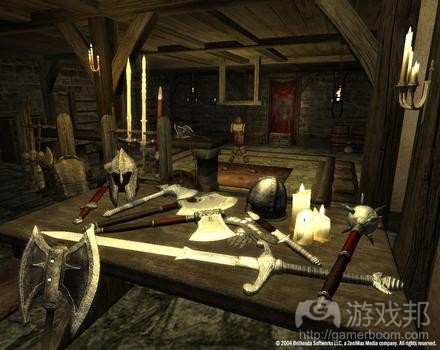阐述游戏沉浸感的心理学概念
作者:Jamie Madigan
当我们说到一款好游戏时,我们经常提到“沉浸感”这个词。但它到底是什么意思呢?怎么才能增加游戏沉浸感?问5个人,你可能会得到10种观点,但心理学家早在几十年前就一直在研究各种媒体的沉浸感,所以他们也许能给出这些问题的答案。
只是,他们并不称我们所谓的“沉浸感”为“沉浸感”,他们称之为“临场感”,后者听起来显然不如前者那么酷。至于我们如何感知媒体,研究者已经鉴定了若干种临场感,但我认为最接近玩家所谓的“沉浸感”的是其中的空间临场感。
简单地说,空间临场感通常被定义为“当媒体用户把媒体内容被当作‘真实的’东西来感知时,媒体用户就会感觉自己在空间意义上,置身于这个媒体环境中”;这种感觉就是空间临场感。也就是说,当用户开始感觉自己就是游戏所创造的世界中的“那里”时,游戏(或任何其他媒体,如书籍或电影)就使玩家产生一种空间临场感。处于沉浸感中的人往往只考虑在虚拟世界的情境中是合情合理的选择。例如,沉浸于《荒野大镖客》的玩家更可能选择在游戏中显得合理的旅行方式,如坐驿站的马车,而不是选择菜单栏中的快速旅行,因为后者脱离了游戏情境。对媒体沉浸得越深的玩家就越喜欢前者。
空间临场感(沉浸感)的理论
为什么会这样?那么使玩家觉得自己生存在现实世界背后的游戏怎么样呢?理论是很丰富的,但几年以前,Werner Wirth等研究人员组成的团队已经通过研究总结出一套统一的理论。如下图所示:
(看来是相当简单的……)
我们只看与玩家最相关的部分。
基本上,Wirth等人的理念认为,空间临场感的发生要经过三个步骤:
1、玩家在头脑中形成游戏展示给他们的世界或空间的影象。
2、玩家开始以这种基于媒体的空间(游戏世界)作为自己“在”哪里的参考点。
3、获益!
所以,基本上这个过程始于,玩家通过各种线索(例如图像、移动、声音,等等)形成游戏虚拟的空间的心理模型和对他们能感受到的这个世界的假设。一旦对游戏世界的心理模型产生,玩家就必须有意识或无意识地判断,自己是否感觉到自己当前是处于想象中的世界还是真实的世界。当然,值得注意的是,这个判断不一定是有意识的,不一定要经过大脑前额皮质(游戏邦注:前额皮质是决定包括语言、社交行为和决策等复杂思考和行为的关键部分)的作用。玩家可以是无意识地、悄悄地、不断地进入和退出这个心理模型。
研究人员已经对这两个步骤的发生进行广泛的研究,但我认为出于我们的目的,我们不妨直接跳到他们发现的能促进这些步骤产生和创造沉浸感的媒体(游戏)和人(玩家)的特性。
导致空间临场感的游戏特性
促进沉浸感的游戏特性大概可以分成两类:一类负责创造游戏环境的丰富的心理模型,另一类负责创造游戏环境中的事物之间的一致性。
我们先理解一下所谓的“丰富”的概念。以下几点虽不详细,但都与“丰富”有关:
1、感觉信息的渠道多
2、感觉信息的完整
3、对认知要求高的环境
4、生动的和有趣的叙述、情节或故事。
“感觉信息的渠道多”意味着感官信息的生效是一前一后的,联系得非常紧密,在这种情况下,沉浸感就会更强。例如,一只鸟飞过头顶,很好;如果能听到它的叫声就更好了。在这里,3D可能也有重要作用,我们都知道视觉革命是空间临场感的新时代的先导。
(《荒野大镖客》具有很强的沉浸感,部分是因为许多东西都是紧密地生效的,不需要玩家费太多想象力去填补空隙。)
“感觉信息的完整”意味着玩家对游戏世界形成的心理模型是非常完整的,没有太多需要玩家填补的空白。抽象和自圆其说(例如,玩家看到小镇里一个人也没有,就猜想是因为瘟疫)是沉浸感的大敌。《刺客信条2》的沉浸感很强,是因为它的小镇到处是人,而且这些人都在做着真正的人会做的事。熟悉的环境使玩家可以轻松地填补空白,而不需要跳出游戏世界思考。很多人都知道西大荒是什么样的,《荒野大镖客》以它为原型构建世界,极大地促进临场沉浸感。
“对认知要求高的环境”是指,玩家必须运用大量脑力资源来专注于游戏中发生的事。这对强化沉浸感是非常有益的,因为如果玩家的脑力都被分配给理解或探索游戏世界,那么玩家就不太会注意到游戏世界中可能让他们意识到“你是在玩游戏”的问题或缺陷。
最后,你会一直被“生动的和有趣的叙述、情节或故事”吸引着。事实上,这是书本创造沉浸感的唯一工具,而它对游戏也适用。好的故事除了把玩家的注意力吸引到游戏中,使游戏世界显得更加可信,也占用脑力资源。
说到与“一致性”有关的游戏特性,我们有:
1、游戏世界中没有不协调的视觉线索
2、游戏世界中的行为是始终如一的
3、游戏世界的表现是完整的
4、与游戏世界的物品产生互动作用
“游戏世界中没有不协调的视觉线索”是另一个促成空间临场感的前提。如果我们讨论电影中的这个概念,我会举这样的一个例子:原本可信的场景中突然出现一个长杆话筒。这就必然使观众反应过来“哦,这只是游戏。”不和谐的东西还包括HUD、教程信息、敌人头顶上出现的伤害数值、成就提示、好友通知,等等。这就是为什么游戏内置广告对沉浸感的破坏那么大——看电影时,如果你发现Adam Sandlar的电影中植入25个广告,你还会专心想象你正在努力拯救人质吗?
(严肃地说,谁会使用这种东西来做录音日记?)
“游戏世界中的行为是始终如一的”意味着,游戏世界中的角色、物品和其他东西的行为正如你所希望的那样发生。值得强调的另一点是,这些线索在整个体验中必须是合理的、一致的。这是为什么我会认为《生化奇兵》的录音日记破坏了原本非常强的沉浸感:谁会记录声音日记,把它分成20段,放在专用的磁带放音机里,然后叫玩家去各种公共场的角落里找这些片段呢?这不科学。
“游戏世界的表现是完整的”是指,关于你的游戏创造的虚拟世界的空间线索不能突然出现又突然消失。这正是每一次玩家看到加载页面、教程或游戏菜单时出现的事。当这种事发生时,游戏世界简单就是消失了,而我们是不可能对不存在的东西产生沉浸感的。
“与游戏世界的物品产生互动作用”大概与上述的“丰富”类似,但我把它归类到“一致性”中,是因为它是给予玩家行动反馈的另一种方式,让玩家感觉环境的各个部分之间具有一致性。操作机器、与NPC对话和物理现象都使玩家觉得游戏世界的各个部分是紧密结合在一起的。
(《湮灭》和《辐射3》具有很强的沉浸感是因为它们允许玩家与几乎所有东西产生互动作用。)
导致空间临场感的玩家特性
当然,玩家本身对其是否沉浸于游戏也是有一定影响的。有些人的空间能力就是更强,可以更快地形成更加生动的心理模型。研究人员发现,那些具有“全神贯注”特点的人能更快对某物着迷。
有时候玩家会产生主动的作用。有些玩家就是想相信幻觉,把自己的偏见导向接受“我就在那里”的假设。在这种状态下,他们会需要更少的证实信息来接受假设,更少的反驳信息来拒绝假设。这类似于“姑且相信”,也就是玩家为了好好玩游戏,主动忽略不合理的东西(游戏邦注:如打了敌方战士那么多子弹,对方居然还不死)。
其他研究人员还指出他们所谓的“介入感”的概念,它是指媒体用户渴望在信以为真的世界中活动,使之与自己的生活保持平行关系,根据他们自己的设计影响变化。对我而言,这似乎是对“有些人喜欢角色扮演”的过度说法,这会直接导致更深的沉浸感。
任何玩家都可以举出突然中断他们的沉浸感的例子。心理学家已经研究、分类了很多例子。但这不是说,所有游戏都应该力求沉浸感。我认为在所有媒体中,游戏是独一无二的。没有沉浸感,游戏仍然可能是好游戏,有些游戏甚至因为没有沉浸感才成为好游戏。但这是件好事,意味着游戏设计师可以用很多种方式来创造优秀的艺术品。(本文为游戏邦/gamerboom.com编译,拒绝任何不保留版权的转载,如需转载请联系:游戏邦)
The Psychology of Immersion in Video Games
by Jamie Madigan
Along with “OMGDUDESOAWESOME” one of the words that gamers like to toss around when describing their favorite titles is “immersive.”1 But what exactly does that mean? And what makes a game immersive? Ask 5 people and you’ll probably get 10 opinions, but psychologists have been studying immersion in various kinds of media for decades so they could probably shed some light on those questions.
Except they don’t call it “immersion.” Instead, they call it “presence,” which, admittedly, isn’t as cool. Regardless, researchers have identified several kinds of presence in regards to how we perceive media but it’s spatial presence that I think comes closest to what gamers think of as “immersion.”
Briefly, spatial presence is often defined as existing when “media contents are perceived as ‘real’ in the sense that media users experience a sensation of being spatially located in the mediated environment.”2 The idea is just that a game (or any other media from books to movies) creates spatial presence when the user starts to feel like he is “there” in the world that the game creates. People who experience immersion tend to only consider choices that make sense in the context of the imaginary world. Someone immersed in Red Dead Redemption, for example, might be more likely to use travel methods that make sense within the game, like stagecoaches, instead of methods that don’t, like fast traveling from a menu screen. People immersed in media also tend to enjoy it more.
A Theory of Spatial Presence (aka, Immersion)
But how does this happen? What about a game and what about the player makes her feel like she’s leaving the real world behind? Theories abound, but a few years ago Werner Wirth and a team of other researchers sat down to consolidate the research and come up with one unified theory.3 Here it is:
Figure 1: It’s just that simple…
Woah, woah, woah. Sorry. Let’s just back up and take a simplified look at the parts most relevant to us gamers.
Basically, Wirth et al.’s theory says that spatial presence happens in three steps:
Players form a representation in their minds of the space or world with which the game is presenting them.
Players begin to favor the media-based space (I.e., the game world) as their point of reference for where they “are” (or to put it in psychological gobblety-gook, their “primary ego reference frame”)
Profit!
So, basically, the process starts with players forming a mental model of the game’s make-believe space by looking at various cues (images, movement, sounds, and so forth) as well as assumptions about the world that they may bring to the table. Once that mental model of the game world is created, the player must decide, either consciously or unconsciously, whether she feels like she’s in that imagined world or in the real one. Of course, it’s worth noting that this isn’t necessary a conscious decision with the prefrontal cortex’s stamp of approval on it. It can be a subconscious, on the sly, slipped into sideways and entered and exited constantly.
Researchers have extensively studied how these two steps happen, but I think it’s more interesting for our purposes here to skip to the bit about what qualities of the media (i.e., game) and person (i.e., player) that they’ve found facilitate both of these steps and create immersion. So let’s do that.
Game Characteristics Leading to Spatial Presence
Characteristics of games that facilitate immersion can be grouped into two general categories: those that create a rich mental model of the game environment and those that create consistency between the things in that environment.
Let’s take the concept of richness, first. This isn’t an exhaustive list, but richness relates to:
Multiple channels of sensory information
Completeness of sensory information
Cognitively demanding environments
A strong and interesting narrative, plot, or story
Multiple channels of sensory information means simply that the more senses you assault and the more those senses work in tandem, the better. A bird flying overhead is good. Hearing it screech as it does so is better. 3D may also play a role here, and we can all agree that smell-o-vision will herald in a new era of spatial presence.4
Red Dead Redemption is immersive in part because so many things work in tandem and it doesn’t leave many gaps to be filled in by the player’s imagination.
Completeness of sensory information means that the fewer blanks about the mental model of the game world that the player has to fill in, the better. Abstractions and contrivances (there are no people in this town because of, uh, a plague! Yeah!) are the enemy of immersion. Assassin’s Creed 2 was immersive because its towns were filled with people who looked like they were doing …people stuff. Dealing in a familiar environment also allows the player to comfortably make assumptions about those blank spaces without being pulled out of the world to think about it. Knowing what the wild West is supposed to look like and having Red Dead Redemption conform to those stereotypes goes a long way towards creating spatial presence.
Cognitively demanding environments where players have to focus on what’s going on and getting by in the game will tie up mental resources. This is good for immersion, because if brain power is allocated to understanding or navigating the world, it’s not free to notice all its problems or shortcomings that would otherwise remind them that they’re playing a game.
Finally, a strong and interesting narrative, plot, or story will suck you in every time. In fact, it’s pretty much the only thing in a book’s toolbox for creating immersion, and it works in games too. Good stories attract attention to the game and make the world seem more believable. They also tie up those mental resources.
Turning to game traits related to consistency, we have:
Lack of incongruous visual cues in the game world
Consistent behavior from things in the game world
An unbroken presentation of the game world
Interactivity with items in the game world
Lack of incongruous visual cues in the game world is one of the more interesting precursors to spatial presence. If we were discussing the same concept in movies, I’d cite the example of seeing a boom mic drop into an otherwise believable scene. It’s anything that reminds you that “Yo, this is A VIDEO GAME.” Examples might include heads up displays, tutorial messages, damage numbers appearing over enemies’ heads, achievement notifications, friends list notifications, and the like. It’s also the reason why in-game advertising wrecks immersion so much –seeing twenty five instances of ads for the new Adam Sandlar movie while trying to rescue hostages kind of pulls you out of the experience.
Seriously, who would use one of these things to keep an audio diary?
Believable behavior from things in the game world means that characters, objects, and other creatures in the game world behave like you’d expect them to. It’s also worth noting that the cues need to make sense and be constant throughout the experience. This is one reason that I think Bioshocks’s audio logs kind of hurt the game’s otherwise substantial immersion: Who the heck records an audio diary, breaks it up into 20-second chunks, puts them on their own dedicated tape players, and then wedges those players into the various corners of a public place? It doesn’t make any sense.
An unbroken presentation of the game world means that the spatial cues about the imaginary world your game has created should not just up and vanish. Which is exactly what happens every time you get a loading screen, a tutorial, or a game menu. When that happens, the game world literally disappears for a few minutes, and we can’t feel immersed in something that isn’t there.
Interactivity with items in the game world could probably fit under the “richness” list above, but I include it with consistency because it’s another way of giving the player feedback on actions and a sense of consistency between various parts of the environment. Operating machines, talking to NPCs, and fiddling with physics makes it seem like the various pieces of the world fit together consistently.
Games like Oblivion and Fallout 3 are immersive because they let you interact with almost everything.
Player Characteristics Leading to Spatial Presence
Of course, players have some say in how immersed they get in a game. Some people just have more spatial ability and can build those mental models of game worlds more readily and make them more vibrant. And researchers have found that people have an “absorption trait” which means that they’re quicker to get fascinated by something and drawn into it –something I like to think of this as “the fanboy gene.”
Other times the player takes a more active role. Some players simply want to believe in the illusion, and will induce their own bias towards accepting the “I am there” hypothesis. In this state, they’ll require less confirmatory information to accept that hypothesis and less disconfirming information to reject it. This is also similar to the idea of “suspension of disbelief” where players wilfully ignore stuff that doesn’t make sense (like thunderous explosions in space or the fact that enemy soldiers can soak up a dozen of gunshots without going down) in order to just have a good time.
Other researchers have also pointed to a concept they call “involvement” which is a media user’s desire to act in the make-believe world, to draw parallels between it and his life, and to effect changes in it according to their own design. To me, this seems like an overly fancy way of saying “some people like to role-play” which leads directly to greater immersion.
So there you have it. Everybody can cite examples of things that yank them out of the game experience, and it turns out that psychologists have examined, classified, and isolated a lot of them. This isn’t to say, though, that ALL games should strive to BE immersive. I think games are kind of unique in all media in that this is so. A game can still be a good game without being immersive, and maybe some types of games are better if they AREN’T immersive. But that’s the great thing: game designers have a lot of paths that they can take to good art.(source:psychologyofgames)
下一篇:完成一款游戏需要掌握的15个诀窍











































 闽公网安备35020302001549号
闽公网安备35020302001549号